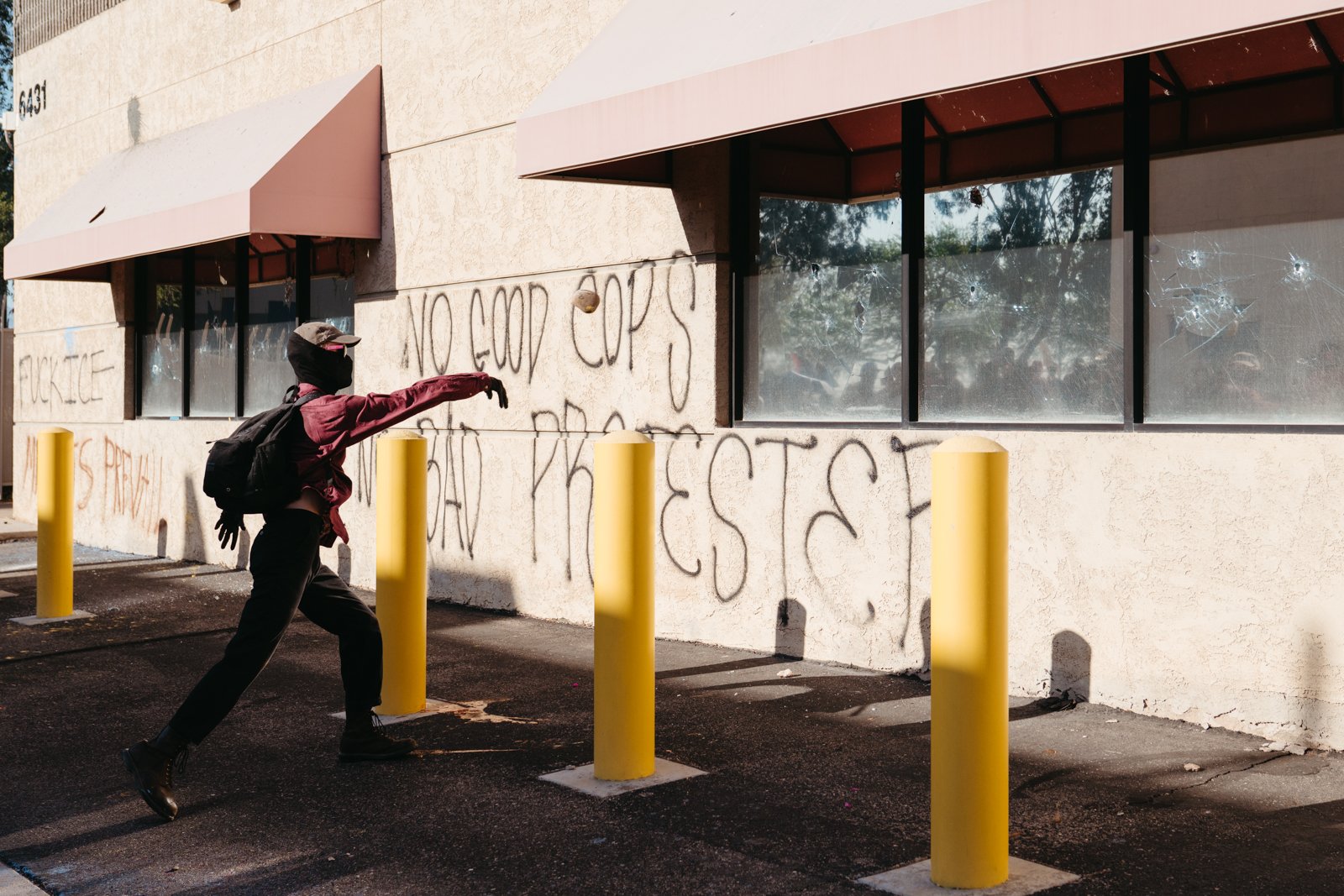
By Anonymous
While LA fought off ICE raids in June, Tucson remained mostly quiet. There were the appropriate outraged lectures on social media and “peaceful” demonstrations outside the federal building, with plenty of organizer back-patting afterwards, but little material result. Although there had been small indicators of disenchantment and a desire for more, including some tense rapid response callouts and a demo at a hospital which had allegedly called ICE on a patient that ended in a brief standoff with the police, this energy had not yet found any meaningful outlet. Until the flyer appeared.
It was different from the other ones going around, no clip art raised fists or collection of logos from endorsing organizations. Just a picture of two cop cars vandalized in LA, the address of Tucson’s ICE office, and a call to rally nearby at 4:30 on June11 with “masks, flags, noisemakers, and sick ass cars.” No one knew who made it or where it first appeared. It spread through the social media of hardcore bands, landscaping companies, and car clubs. Although no organizers put their names on it, their intent was unmistakable: This was not a civil expression of displeasure. It was time to bring the fight to ICE.
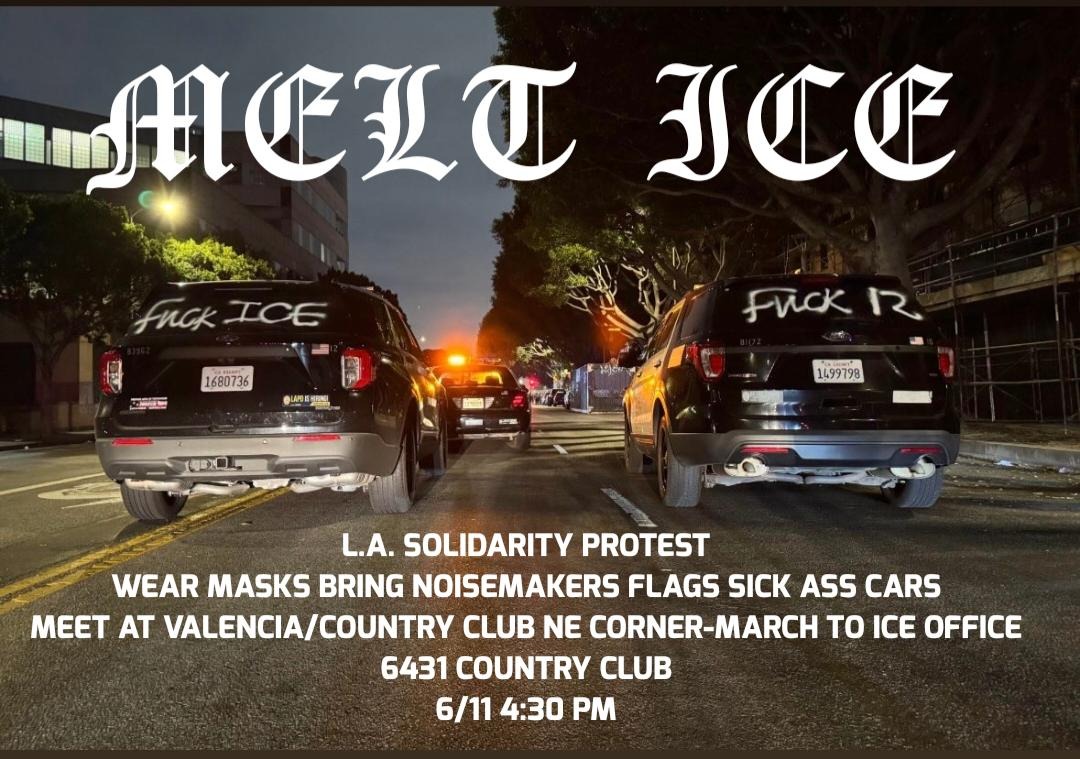
By 4:30 p.m. on the 11th, it was well above a hundred degrees, and several hundred people had already gathered on the corner of Valencia and Country Club. Dozens of self-organized small groups had formed, some handing out water and snacks, some playing music, some waving banners at passing cars. A surprisingly high number (for Tucson) adopted a more confrontational appearance, with balaclavas and backpacks signaling they were prepared for confrontation. The Party for Socialism and Liberation (PSL) and their more recent counterpart the Revolutionary Communists of America were both present as well, with their usual megaphones and chants. By 5 p.m. even that was drowned out when one of the grey-bloc’d [1] affinity groups came to the front with a louder sound system. One of them gave a short, angry speech connecting ICE operations, Tucson’s border enforcement and military research industries, local gentrification, and the genocide in Gaza, followed by a call to march to the ICE office. The crowd mobilized immediately, setting off towards the office with cheers and chants.
When marchers arrived at the office it had already been cordoned off with metal barricades manned by five guards in “security” patches [2]. The march barely slowed. Some at the front began immediately dismantling the barricades, while others climbed over the low walls surrounding the office parking lot. Security responded with pepper spray but didn’t have the manpower to hold the line, and the crowd pushed them back about 50 yards to the gate of ICE’s motor pool. The office was just another ten yards distant. The guards doused demonstrators with pepperballs and reformed their line and though their numbers were small, it must be said they displayed uncommon resolve. Over the course of perhaps 20 minutes, the frontline of the crowd faced off with the line of guards, making slow but steady progress at pushing them back the entire time.
The same could not be said for about half of the marchers, who remained back at the initial barricade line, shouting half-hearted admonitions against violence. Although the front half of the march had so far kept initiative and courage, they began to falter. The widening gap (both physical and ethical) between the front and rear elements of the march would have demoralized anyone. An unknown speaker jumped on the mic and admonished the rear crowd, their voice cracking as they screamed “Don’t be a coward! They’re fighting in LA! They’re fighting in Gaza! Why won’t you fight here?.” It worked on a few of the holdouts, who trudged forward, not quite to the front, but at least filling in the gap. The rest of the peaceniks began realizing this was not their moment and slunk back to their cars.
Meanwhile, the front line threw fireworks and paint bombs in a series of failed attempts to break the guards’ formation. This kept the tension high, but the stalemate was rapidly crystallizing, and everywhere one heard the kind of whispers that usually presage defeat, “should we try a wedge or something?” “We can’t stay out too long in this heat.” “I just don’t know if people are down enough.”
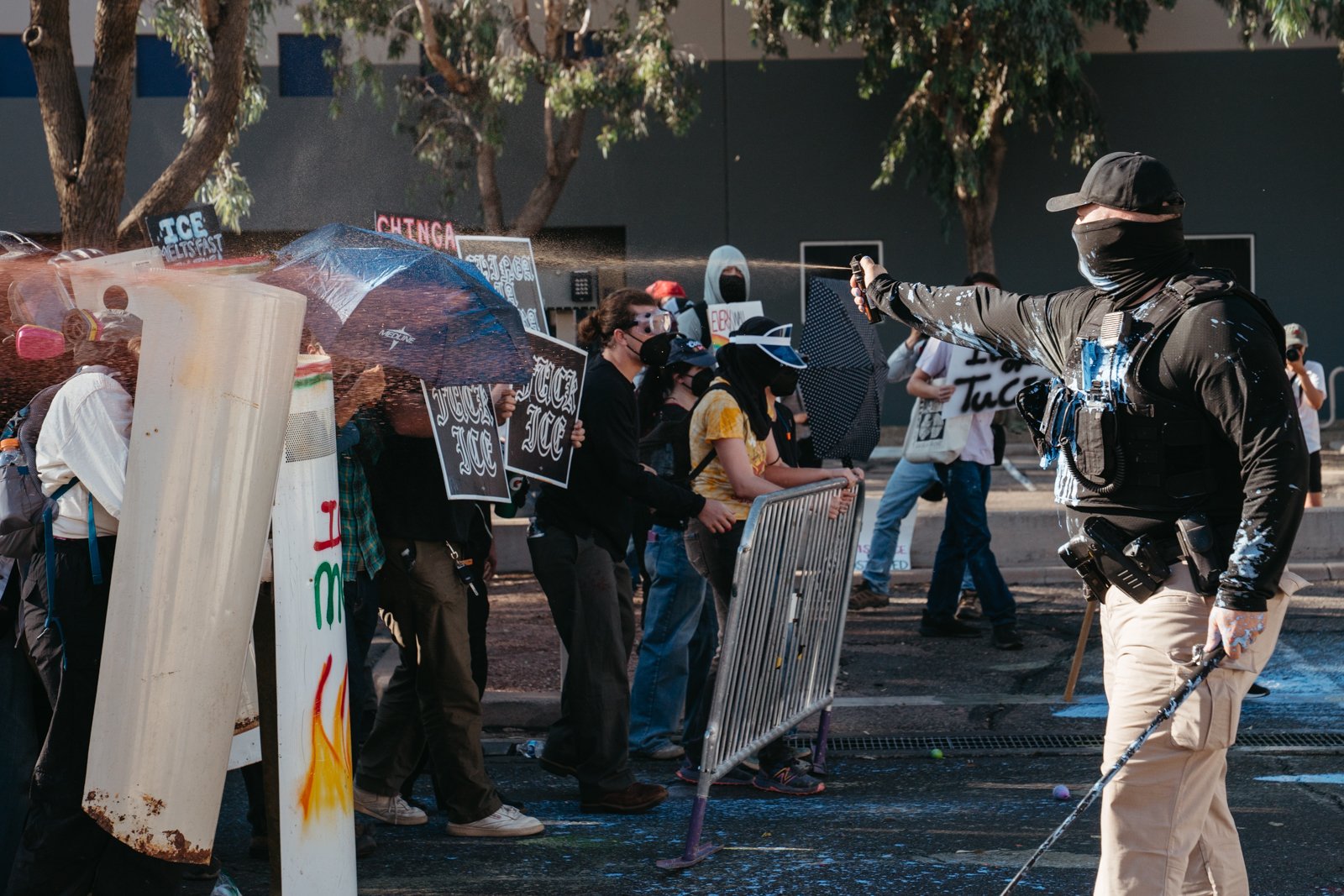
The stalemate broke with the sudden arrival of four full length metal shields, made from water heaters cut in half lengthwise and spray painted with revolutionary slogans. The crowd was ecstatic; many of the people lingering in the middle zone ran up to the front line. Unaffiliated affinity groups rapidly organized into a respectable shield wall and advanced. The guards adapted quickly, rolling flashbangs under the shields and pulling them down to pepper spray the stunned bearers. The advance paused for a moment, but morale was too high to stop, and pepper-sprayed shieldholders rotated out for replacement by fresh hands. Then, another miracle: in a moment which has since gone viral online, an especially clever demonstrator flanked the guards who were focused on the shield wall and doused them with paint from a modified fire extinguisher. Another militant picked up a discarded metal barricade and hurled it at the pepperball gunner. This broke them. The guards announced a retreat and backed down the alley, screeching “back up! back up!” at the demonstrators while they themselves retreated, exposing the entire flank of the ICE building they’d been tasked with protecting. The office had been taken.
With security on the backfoot the shield group surged forward, forcing the guards farther down the alley to prevent a counterattack. Once demonstrators were sure they had unopposed access to the office, they wasted no time taking advantage of it. A number of people split off from the shield wall and began a thorough redecoration. Spray paint, window punches, and rocks set aside for this moment materialized and were put to good use. After only a few minutes the office was missing most of its windows and bore new murals reading “ICE MELTS WITH FIRE” “KILL YOURSELF ICE” and “MIGRANTS PREVAIL.” Rocks were thrown through windows into the interior of the office and over the fence into the motor pool, but both were sadly too well fortified to be properly addressed, precluding more significant damage to ICE resources.
As the vandalism of the office began to reach its limit, word was passed down the line that local police were beginning to arrive. Couriers ran from the rear guard down the alley and advised shieldholders to regroup back on the street to avoid a kettle (with the guards pushed to the far end, the crowd was essentially enclosed in a narrow alley and at risk of being trapped and arrested en masse). While this was a significant feat of tactical coordination, it turned out to be an unfounded fear. Tucson Police Department (TPD) was able to assemble a hasty riot line, but adopted their usual cautious approach. Officers lined up in the parking lot of a nearby door manufacturer, sweating under the weight of their gear in the Arizona summer and waited for demonstrators to wear themselves out and disperse. The shield wall reformed facing this line to block potential projectiles while others taunted the cops, but no attack came, and demonstrators soon began to filter out, wisely recognizing that their goal had been accomplished and it was better get back to their cars before nearby streets could potentially be closed or reinforcements arrived and began attempting to make arrests.
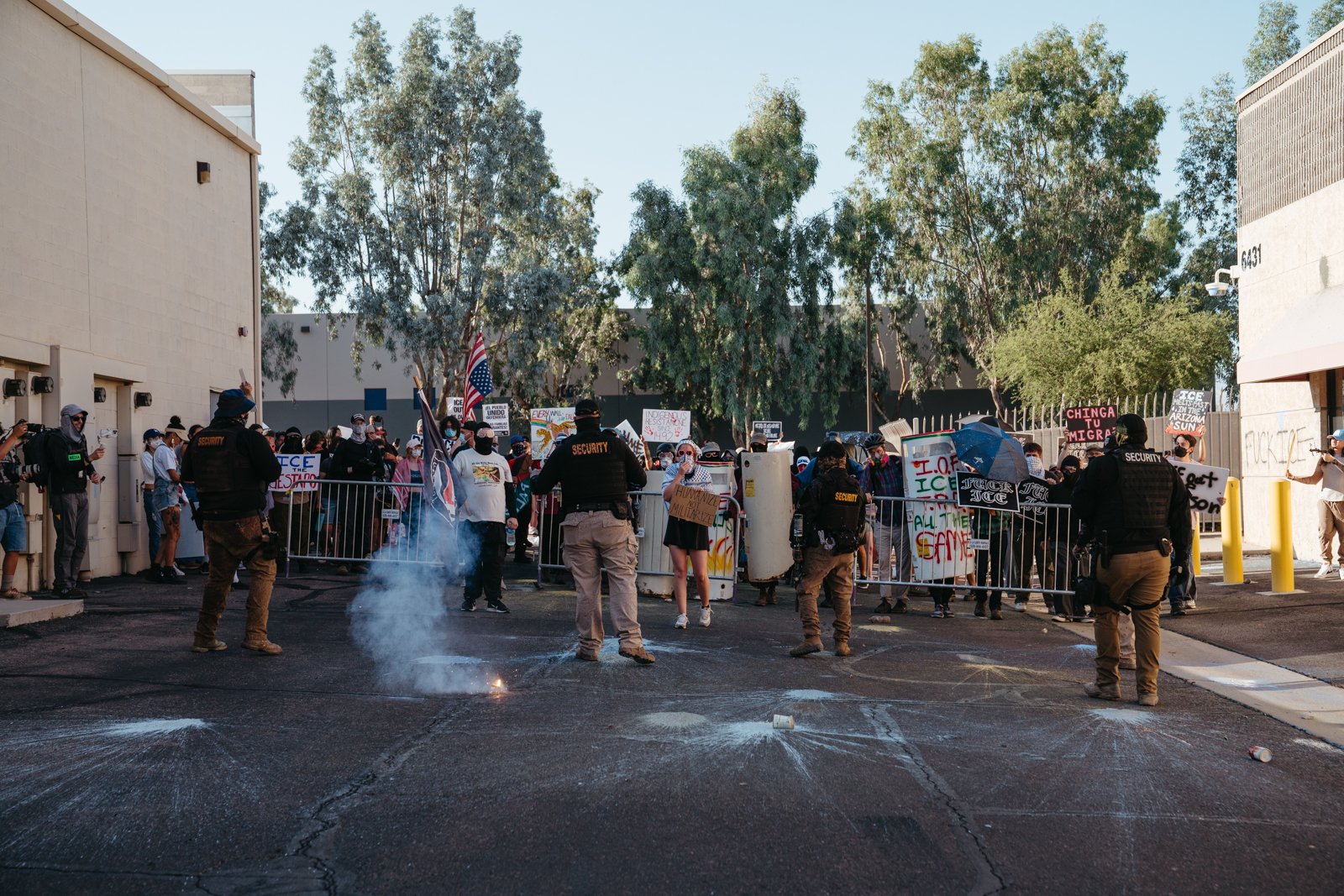
Many, however, were too hyped up to leave, and a new standoff formed between p
protesters in the office lot and the police line below. Neither side seemed to have much motivation to advance on the other, and the action began to transition from an infrastructural attack to a symbolic protest. Once the stalemate at the riot line became clear, most protesters fell back to the original meeting point along the main road a block away. Some remained on the sidewalk there while a few of the braver among them spread out in a loose line blockading Valencia Road. This was a noble effort, but too little too late.
As the protest’s strength dwindled, police had brought in resources from all over the city and were finally prepared to go on the offensive. Around 7:30 p.m. the cops made their move. The riot line reformed on Country Club Road and advanced on the protest, grabbing anyone who did not immediately fall back. Demonstrators resisted admirably with some well-executed de-arrests [3], but three people were still brutally arrested, and the action finally folded [4].
It is still too early to say what the long-term accomplishments of this action are. For the past couple months, ICE operations in Southern Arizona have remained much slower-paced than California or Phoenix, meaning there has been little opportunity to observe how their operations may change in Tucson specifically. Still, while physical damage to ICE resources was not able to cross the threshold from vandalism to material impedance, this action represents a significant turning point in Tucson’s revolutionary movement. Tucson is a city which has remained mired in symbolic, “non violent” protests, and even the more conflictual moments have been defined more by defense against arrest than an offensive orientation. The action of June 11 represents the first time in several years that organizers have not only selected a materially strategic target, but the crowd has come prepared (without instruction!) to both carry out illegal, destructive tactics and to get away with it. This suggests a new strategic orientation towards sustained offensive movements which is likely to pay serious dividends as social crisis deepens.
For those who are interested in nurturing such an orientation in their own context, a few points of advice are enumerated below:
If You Build It, They Will Come:
Tucson does not (yet) have a tradition of militant street action. Still, hundreds of people threw down when given the opportunity. It is reasonable to assume that all over the country people are willing to use militant tactics but not experienced enough to take initiative. By doing the logistical work of choosing a place and time, but not taking control of the whole action, the flyer-makers created a structure which empowered these people to act without fear of being labeled provocateurs. This also prevented the concerns about “nonviolence” from demobilizing the crowd, as calls for peace and order became “outside agitation” instead of orders from above.
Get Comfortable With Marketing:
Although the flyer which sparked this action had no explicit ideological content, it still took clear positions. By using an image of destroyed cop cars for the background, it implicitly celebrated and approved conflictual resistance. The header text was in an old English font commonly used in Chicano street art, situating the action as aligned with the working class Latino community, not activist subculture. Most importantly, it looked good. It made people want to be a part of it. Accordingly, it was shared widely outside of the typical non-profits, appearing on the pages for hardcore bands and neighborhood associations alike. Where other recent demos had been overwhelmingly white boomer liberals, this one featured large groups of young punks and working class locals, who were far more courageous and creative than the typical activists despite not being as legibly political. Anarchists especially tend to be squeamish about the idea of “marketing,” seeing it as manipulation which restricts people’s autonomous decision making. When done with care, however, good outreach serves as a subtle “invitation” which empowers people to act more freely.
Loudest Sound System Wins:
The anonymous speaker who started the march never identified themself or gave any bona fides, but just by virtue of being louder than the others the crowd followed their invitation to march on the ICE building. Without this pushback, professional megaphone holders may have completely demobilized the crowd. Comrades who find themselves in this position would be wise to focus on tone over content: the goal is to empower people to act, not give a tactical or ideological lecture.
Tactical Leadership Gets Results:
This action would not have been nearly as successful without the involvement of several highly coordinated small units. Although none of them took orders from a hierarchical organizer, and many didn’t even know (or recognize) each other, they were able to quickly identify an objective and assign themselves to necessary tasks. Their preparedness made them visibly confident taking risks, which galvanized less experienced participants to join the front lines. The affinity group structure also provided an efficient form of collective tactical leadership, facilitating rapid exchange of information and equipment without the vulnerabilities of centralized decision making. Experienced street fighters should show up to actions like this unafraid to take initiative or even give direct instruction to enthusiastic but inexperienced comrades.
The specific tactics used here are worthy of note as well: A shielded core force supported by flanking skirmishers has been winning battles for as long as organized warfare has existed. In fact, simply by following the most intuitive offensive tactics, demonstrators almost perfectly replicated the Zulu “buffalo horn” formation, where offensive “horns” break off the sides of a shield wall to harass the enemy, breaking their formation and facilitating the movement of the massed “head” unit onto an objective. Although the attacking force in this case had enough numerical superiority to theoretically win without much tactical sophistication, many fighters were inexperienced and afraid to advance without protection against assault or arrest. Providing defensive shields kept these people in the fight while providing a distracting target which consumed the guards’ energy, attention, and ammunition. This in turn allowed freedom of maneuver for offensive elements, who attacked the guards directly, broke their formation, and created a momentum which encouraged stragglers to advance, all without getting arrested or struck themselves. Offensive affinity groups often stick to the massed front line, but the success of this concept shows that distributing PPE to frontliners then moving to the outskirts of the crowd to attack with projectiles can be a highly effective, low-risk way to open new possibilities at a demo.
Of course, these principles go the other way too--we stand to learn a lot from how confidence and coordination allowed five security guards with one pepperball gun to hold out so long against a force thirty times their size.
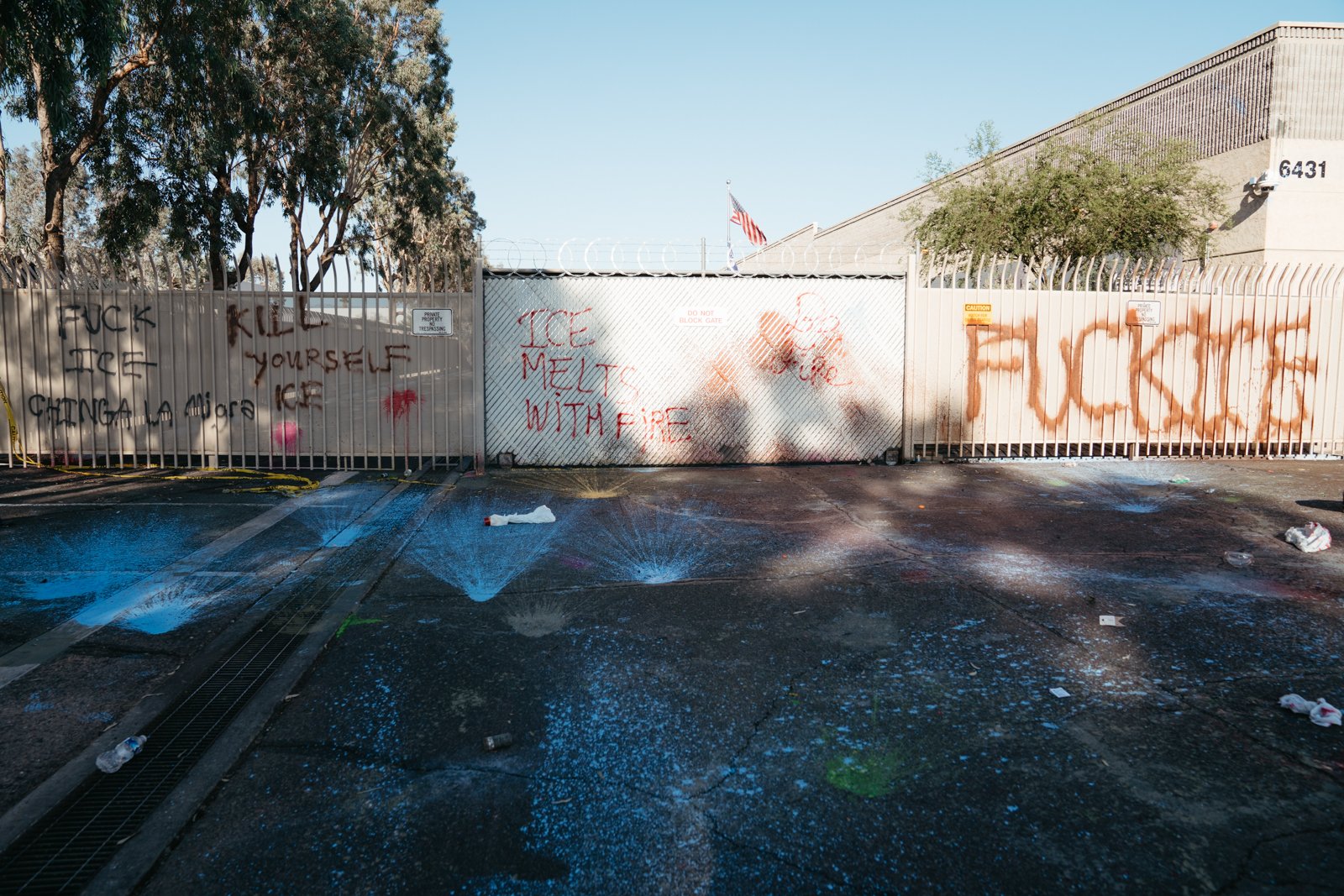
ICE's Resources are Spread Thin by their Current Operations and Local Law Enforcement May be Reluctant to Come to their Aid
Usually security for ICE facilities is provided by a combination of the Federal Protective Service (FPS), who are federal officers under the Department of Homeland Security (DHS), and private security contractors. While it remains unknown to the author whether the officers guarding this facility were really private security or just hiding their status as law enforcement, five officers is completely insufficient to control a rebellious crowd and over the course of hours, ICE never brought in back up to defend their building or support their guards. It is hard to believe they would have been left to fend for themselves if any more resources had been available, but we really don’t know what happened. The day of this action also saw significant ICE raids in Phoenix and Los Angeles and a massive FPS mobilization to secure government facilities across the west coast. This allows for the significant possibility that DHS simply did not have the manpower to secure all their facilities, and left responsibility for smaller offices to contractors and local cops [5]. TPD’s tepid response makes clear this was an idiotic gamble. Many ICE agents have been deployed to California, and PR conscious local authorities in Democratic areas are eager to dissociate themselves from locally unpopular federal policy. Organizers should be aware of these constraints and exploit them while we can.
Look For Target-Rich Environments
The ICE office in Tucson was located in an anonymous “business park” out by the airport, ten miles from downtown. This area contains a number of military contractor offices and logistical hubs crucial to the flow and reproduction of capital. It is also an overwhelmingly working-class Latino area, with a long history of militant self-organization and revolutionary energy. A shift away from downtown “awareness raising” towards actions in logistical/industrial areas is likely to be both popular and effective. It would also be difficult to repress. Many offices, warehouses, and transport hubs are surrounded by massive parking lots and busy roads. Standard riot control tactics adapt poorly to such an environment, which provides nearly infinite flanking and escape routes, privileging a heterogeneous, unpredictable offensive force.
However, this advantage only holds as long as such a force can maintain initiative and mobility. They must be willing to split and regroup as needed to evade police, and to retreat quickly after striking targets. Getting drawn into a prolonged standoff with police or attempting to hold territory means sacrificing the initiative, and makes combatants significantly more vulnerable to snatch squads, kettling, and crowd control weapons, to say nothing of the morale hit from standing around in the heat too long. Special care must also be taken to evade surveillance, especially from aerial platforms [6], as police will often mark targets and wait to arrest them when they are leaving the action or otherwise separate from the crowd. This risk can be somewhat mitigated by changing clothes after or throughout an action, and by carrying obscuring devices such as umbrellas.
Notes:
[1] “Grey-bloc” is a term used to describe a variation on the "black bloc" (where by individuals dress all in black in order to achieve anonymity), that involves a group of people concealing their identities with well-covering, unremarkable street clothes rather than all black garb.
[2] ICE contracts with several private security firms, including both large corporations like G4S and local companies. It is impossible to say for sure what company these guards belonged to, or if they were really private security in the first place, although the author has no concrete reason to believe otherwise.
[3] At least one de-arrester attributed their courage to a training held the day before, speaking to the importance of such events.
[4] After they were run out of Valencia and Country Club, around 100 demonstrators went directly to the site of a nearby joint federal-local police action which was rumored to be an immigration raid. Although it turns out police were actually serving a drug warrant, this quick reaction was impressive, and hopefully implies a future generalization of “rapid response” tactics to impede police action outside of ICE raids.
[5] It is notable that Border Patrol never made an appearance at this action, despite their large presence in Southern Arizona and direct assistance of ICE elsewhere. A possible explanation is that BORTAC agents with crowd control training had already been deployed to other cities, and patrol agents were too far out in the desert to respond on short notice. Of course, simple disorganization or a variety of variables beyond our knowledge could also be responsible for that outcome.
[6] Tucson departments rely on this tactic heavily, likely due to a close relationship with Border Patrol that has left them with a robust air support unit.
Images: Adrian O'Farrill & Paul Ingram